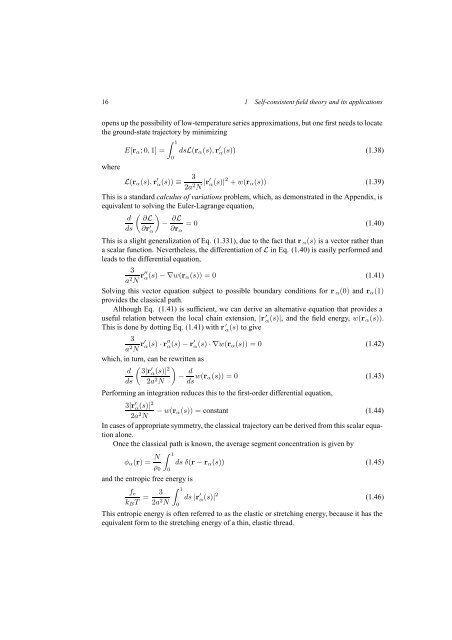Self-Consistent Field Theory and Its Applications by M. W. Matsen
Self-Consistent Field Theory and Its Applications by M. W. Matsen
Self-Consistent Field Theory and Its Applications by M. W. Matsen
Create successful ePaper yourself
Turn your PDF publications into a flip-book with our unique Google optimized e-Paper software.
16 1 <strong>Self</strong>-consistent field theory <strong>and</strong> its applications<br />
opens up the possibility of low-temperature series approximations, but one first needs to locate<br />
the ground-state trajectory <strong>by</strong> minimizing<br />
where<br />
E[r α ;0, 1] =<br />
∫ 1<br />
0<br />
dsL(r α (s), r ′ α(s)) (1.38)<br />
L(r α (s), r ′ α(s)) ≡ 3<br />
2a 2 N |r′ α(s)| 2 + w(r α (s)) (1.39)<br />
This is a st<strong>and</strong>ard calculus of variations problem, which, as demonstrated in the Appendix, is<br />
equivalent to solving the Euler-Lagrange equation,<br />
d<br />
ds<br />
( ∂L<br />
∂r ′ α<br />
)<br />
− ∂L<br />
∂r α<br />
=0 (1.40)<br />
This is a slight generalization of Eq. (1.331), due to the fact that r α (s) is a vector rather than<br />
a scalar function. Nevertheless, the differentiation of L in Eq. (1.40) is easily performed <strong>and</strong><br />
leads to the differential equation,<br />
3<br />
a 2 N r′′ α (s) −∇w(r α(s)) = 0 (1.41)<br />
Solving this vector equation subject to possible boundary conditions for r α (0) <strong>and</strong> r α (1)<br />
provides the classical path.<br />
Although Eq. (1.41) is sufficient, we can derive an alternative equation that provides a<br />
useful relation between the local chain extension, |r ′ α(s)|, <strong>and</strong> the field energy, w(r α (s)).<br />
This is done <strong>by</strong> dotting Eq. (1.41) with r ′ α (s) to give<br />
3<br />
a 2 N r′ α (s) · r′′ α (s) − r′ α (s) ·∇w(r α(s)) = 0 (1.42)<br />
which, in turn, can be rewritten as<br />
(<br />
d 3|r<br />
′<br />
α (s)| 2 )<br />
ds 2a 2 − d N ds w(r α(s)) = 0 (1.43)<br />
Performing an integration reduces this to the first-order differential equation,<br />
3|r ′ α (s)|2<br />
2a 2 N − w(r α(s)) = constant (1.44)<br />
In cases of appropriate symmetry, the classical trajectory can be derived from this scalar equation<br />
alone.<br />
Once the classical path is known, the average segment concentration is given <strong>by</strong><br />
φ α (r) = N ∫ 1<br />
ds δ(r − r α (s)) (1.45)<br />
ρ 0<br />
0<br />
<strong>and</strong> the entropic free energy is<br />
f e<br />
k B T = 3 ∫ 1<br />
2a 2 ds |r ′<br />
N<br />
α(s)| 2 (1.46)<br />
0<br />
This entropic energy is often referred to as the elastic or stretching energy, because it has the<br />
equivalent form to the stretching energy of a thin, elastic thread.
















